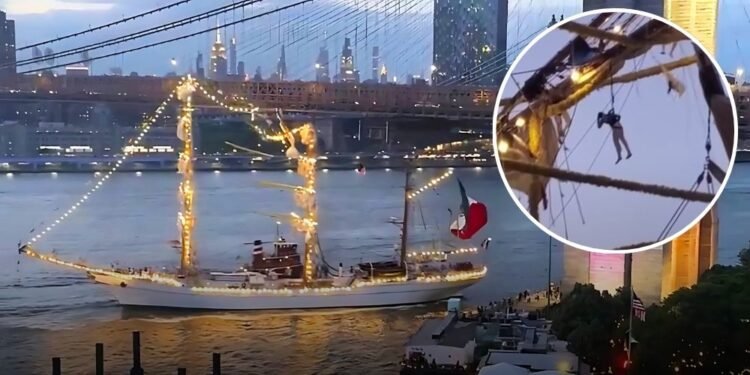The Mexican Navy’s training ship Cuauhtémoc collided with the Brooklyn Bridge, claiming the lives of two cadets and injuring 22 others.
The 297-foot vessel, part of a goodwill tour celebrating Mexico’s naval history, lost power and smashed into the bridge’s pillar, snapping its 147-foot masts. What caused this disaster, and why were sailors perched high on the masts during a routine departure?
The crash stemmed from a mechanical failure, likely in the ship’s auxiliary diesel engine (1,125 horsepower), which supports its wind-powered sails. NYPD Chief Wilson Aramboles reported the Cuauhtémoc lost propulsion and steering control while leaving Pier 17, bound for Iceland.
The East River’s strong tidal currents pulled the ship backward toward the bridge’s Brooklyn side, overwhelming a nearby tugboat’s ability to assist. The bridge’s 127-foot clearance was no match for the ship’s towering masts, which weren’t meant to pass underneath.
Investigators are examining whether navigational miscalculations, such as underestimating the tide’s force, played a role. The National Transportation Safety Board’s “go-team” is analyzing the ship’s voyage data recorder to confirm the engine failure’s cause and assess crew decisions.
The presence of sailors on the masts, captured in dramatic eyewitness videos, reflects a long-standing naval tradition. The Cuauhtémoc, a three-masted barque built in 1982, uses such displays during harbor maneuvers to showcase seamanship and pride.
Cadets climb the rigging and yardarms to manage sails or perform ceremonial duties, a standard practice for training.
On May 17, dozens of cadets in white uniforms were stationed aloft when the masts snapped, leading to the deaths of América Yamilet Sánchez, 20, and Adal Jair Marcos, 22, with others left dangling perilously. The tradition, meant to inspire, turned tragic in the East River’s tight, turbulent waters.
The incident raises questions about safety protocols for tall ships in busy harbors. Still, the cadets’ courage and the Cuauhtémoc’s legacy as a symbol of naval excellence shine through.
As investigations dig deeper, their sacrifice fuels a drive for stronger safeguards, ensuring future missions honor their bravery with safer journeys and a renewed commitment to excellence on the high seas.











